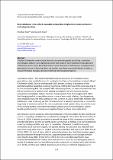Files in this item
New Caledonian crows afford invaluable comparative insights into human cumulative technological culture
Item metadata
| dc.contributor.author | Rutz, Christian | |
| dc.contributor.author | Hunt, Gavin R. | |
| dc.date.accessioned | 2021-02-10T00:39:04Z | |
| dc.date.available | 2021-02-10T00:39:04Z | |
| dc.date.issued | 2020 | |
| dc.identifier | 266674292 | |
| dc.identifier | 1e04ab1d-d0df-4b66-b9d6-1bb82b4818a7 | |
| dc.identifier | 000561440700022 | |
| dc.identifier | 85089321693 | |
| dc.identifier.citation | Rutz , C & Hunt , G R 2020 , ' New Caledonian crows afford invaluable comparative insights into human cumulative technological culture ' , Behavioral and Brain Sciences , vol. 43 , e177 . https://doi.org/10.1017/S0140525X20000187 | en |
| dc.identifier.issn | 0140-525X | |
| dc.identifier.other | ORCID: /0000-0001-5187-7417/work/79918039 | |
| dc.identifier.uri | https://hdl.handle.net/10023/21395 | |
| dc.description.abstract | The New Caledonian crow may be the only non-primate species exhibiting cumulative technological culture. Its foraging tools show clear signs of diversification and progressive refinement, and it seems likely that at least some tool-related information is passed across generations via social learning. Here, we explain how these remarkable birds can help us uncover the basic biological processes driving technological progress. | |
| dc.format.extent | 203466 | |
| dc.language.iso | eng | |
| dc.relation.ispartof | Behavioral and Brain Sciences | en |
| dc.subject | H Social Sciences | en |
| dc.subject | QH301 Biology | en |
| dc.subject | T Technology | en |
| dc.subject.lcc | H | en |
| dc.subject.lcc | QH301 | en |
| dc.subject.lcc | T | en |
| dc.title | New Caledonian crows afford invaluable comparative insights into human cumulative technological culture | en |
| dc.type | Journal item | en |
| dc.contributor.institution | University of St Andrews. Centre for Biological Diversity | en |
| dc.contributor.institution | University of St Andrews. Centre for Social Learning & Cognitive Evolution | en |
| dc.contributor.institution | University of St Andrews. School of Biology | en |
| dc.identifier.doi | 10.1017/S0140525X20000187 | |
| dc.description.status | Peer reviewed | en |
| dc.date.embargoedUntil | 2021-02-10 |
This item appears in the following Collection(s)
Items in the St Andrews Research Repository are protected by copyright, with all rights reserved, unless otherwise indicated.

